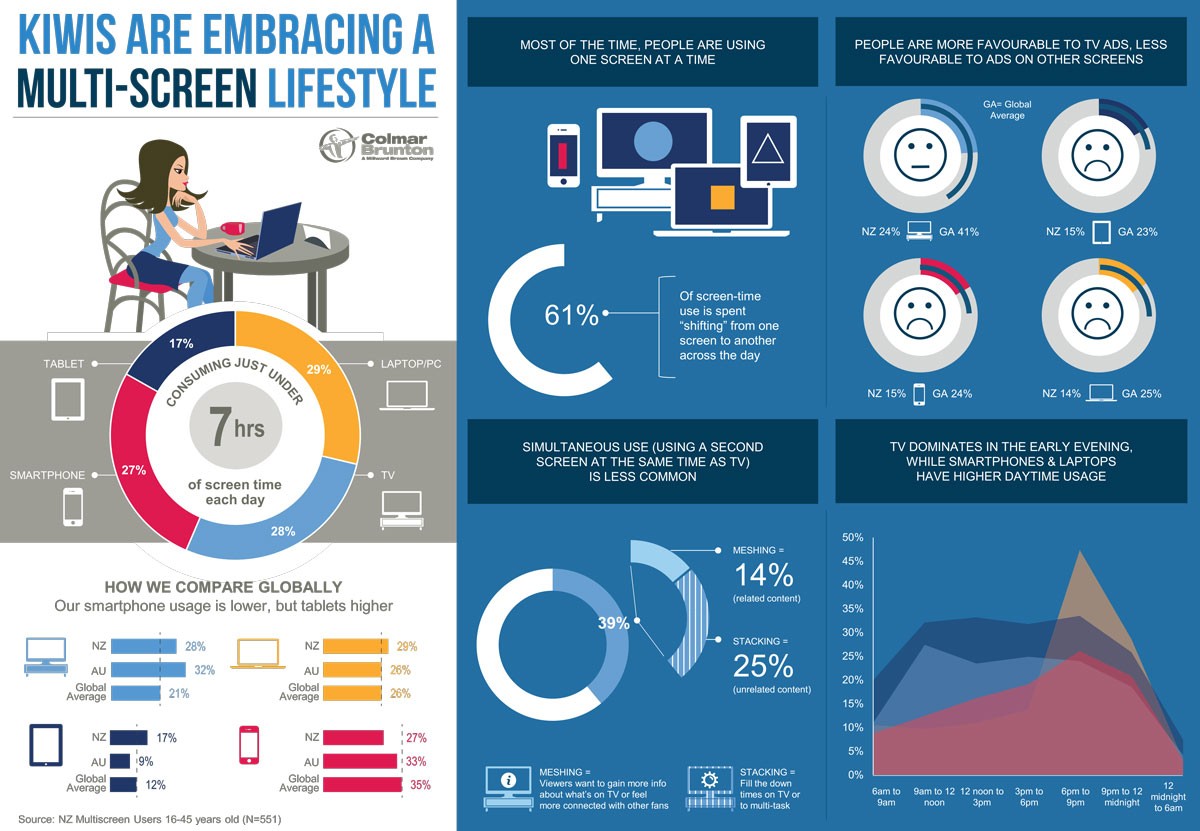New research that lifts the lid on how Kiwi multiscreen users juggle their TV, laptop, smartphone and tablet screens contains critical insights for businesses and reveals that television plays a pivotal role in today’s multiscreen marketing mix.
A Colmar Brunton AdReaction survey on marketing in a multiscreen world confirms Kiwis are embracing a multiscreen lifestyle, spending approximately seven hours a day in front of their lineup of screens. The survey digs into New Zealanders’ multiscreen habits and how they compare to their international counterparts.
Colmar Brunton CEO Jacqueline Ireland says one of the key findings is that compared to the global average and their Australian neighbours, Kiwis are tough nuts to crack when it comes to on screen advertising, which is why it is so important to understand how, when and why consumers are using their various screens.
“New Zealanders’ daily multiscreen use is a little below the global average but ahead of Australia,” Ireland says. “However Kiwis are a lot less receptive to on screen advertising compared to the global average.”
Laptops (29% of screen time), TV (28%) and smartphone (27%) get a fairly even share of Kiwis’ daily attention, ahead of tablets (17%).
When it comes to receptivity to advertising messages, 24% of New Zealand’s multiscreen users are favourable towards TV advertising, well ahead of other screen advertising in New Zealand but a long way below the global average of 41% (but similar to our Australian neighbours).
Just 14% of Kiwi multiscreen users favour advertising on their laptops (global average 25%); Smartphone and tablet advertising enjoy only 15% favourability here compared to a global average of 24% for smartphones and 23% for tablets.
“This makes it critical for New Zealand businesses and marketers to get their multiscreen campaigns right and the first step is to understand Kiwis’ screen use,” Ireland says.
The survey revealed that smartphones and laptops have the most daytime screen use, with TV dominating from 6pm to 9pm. Tablets have a joint use both as work related (daytime) and particularly as a leisure time device.
But Ireland points out that despite the uptake of new technology, TV plays a pivotal role in the mix.
A separate Colmar Brunton NZ On Air survey this year confirmed that TV and radio still deliver the biggest audiences in New Zealand. It also found that combining extra content online with traditional TV extends engagement with TV shows.
“This is reflected in the new multiscreen survey which tells us that, while 61% of Kiwis’ screen time is spent shifting – moving from one screen to another for different tasks across the day – 39% of multiscreen users’ daily screen time is spent in front of the TV while using another screen simultaneously.
“We can break down these simultaneous screen viewing occasions into meshing – where TV and digital screens are being used to consume related content, and stacking – where the content and media tasks are unrelated to what’s on TV,” Ireland says.
Kiwis are ahead of their Australian counterparts when it comes to meshing which consumes 14% of their daily screen time, compared to 11% across the Tasman. But the Australians spend 28% of their daily screen time stacking, ahead of New Zealanders’ 25%. In this country men spend more than twice as much time meshing (19% of screen time) as women (9%).
“Combining overall receptivity with the amount of screen time shows that TV remains the largest New Zealand media opportunity. TV is the most common lead medium, with other screens more commonly used as continuations for related tasks,” Ireland says.
TVNZ General Manager of Data & Insights Jonathan Symons says the survey’s findings reflect the evolving role of television.
“It backs up our experience that viewers are keen to extend engagement with TV shows and advertising when extra online content is offered alongside traditional TV,” he says.
Draft FCB Planning Director Simon Bird agrees that the research indicates that TV delivers greater salience, higher advertisement attention and more favourable attitudes toward advertising than other screens – and all from a similar amount of eyeball time.
“It is a timely reminder that despite considerable and ongoing change in the AV world and a whole host of interesting new media options becoming available, TV in its current form is still an extremely influential channel for advertisers,” he says.
Jacqueline Ireland says the New Zealand and international survey results reveal exciting opportunities for multiscreen campaigns and the keys to getting multiscreen marketing right. “For brands meshing is the sweet spot and there are real opportunities here to bring screens together to provide a much more interactive experience. For example campaigns that include TV programme sponsorships linking to apps, voting, mobile play-alongs and online extras enhance the brand experience creating greater engagement and deeper connections.”
The survey results also identified four keys to effective multiscreen marketing:
- Be connected – The biggest multiscreen opportunity is not simultaneous connections between screens, but rather ensuring a presence across screens to build multiple touch points and amplify content;
- Be considered – Understand consumer device preferences and behavior together with campaign objectives to plan your multiscreen strategy – which device is better for which job?
- Be consistent – Whenever someone engages with you on any screen, your brand experience and messaging should be consistent (or at least complementary) in a way that leads to an engaging whole;
- Be compelling – Use mobile-friendly, shareable content that entertains first, informs second but also keeps the brand central.
The results come from a survey of 551 New Zealand multiscreen users aged 16-45 years with a margin of error of + or –4%.
Share this Post



